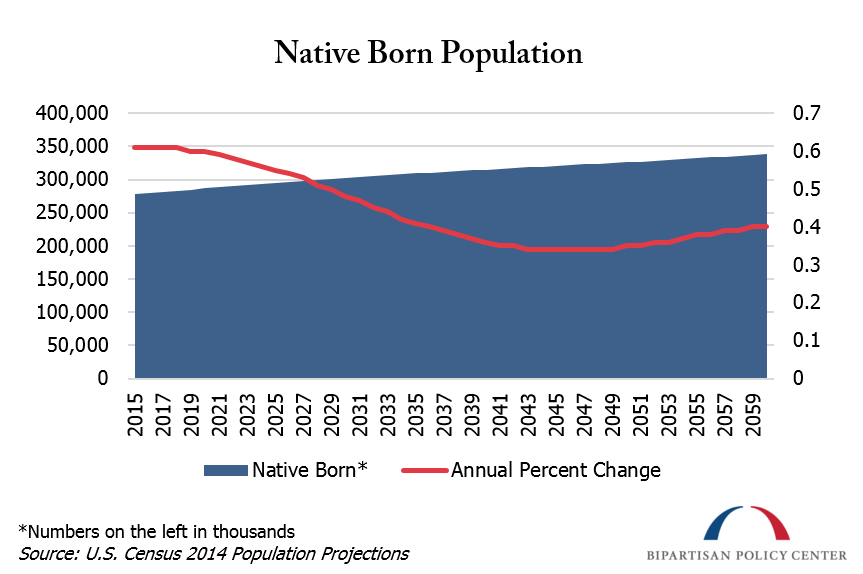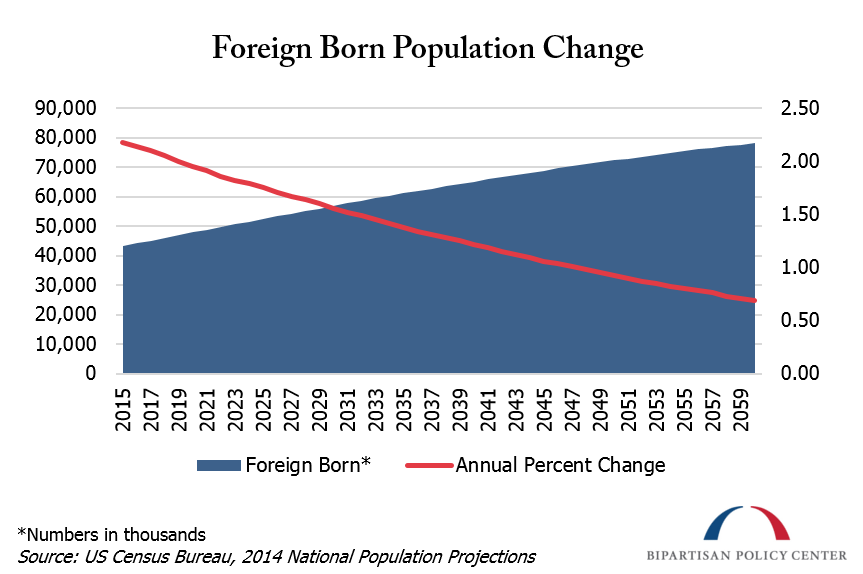Looking Forward: The Future of U.S. Immigration
Key takeaways:
- The latest Census Bureau data projects continued population growth for the United States, largely due to immigration.
- As native-born population growth slows, immigration will continue to be a critical source of population growth which is necessary for a healthy economy.
Immigration plays a critical role for the United States in maintaining healthy population growth, helping to ward off the population stagnation or decline that several other major economies are facing. Recent population projections from the Census Bureau contain new and updated information about the shifting landscape of U.S. immigration and the country’s demographic outlook. According to the latest data, immigration will continue to account for most of the country’s population growth in the upcoming decades.
In 2015, the total U.S. population was estimated at 321 million. That number is expected to increase by about 2.1 million people per year to reach 417 million in 2060. On average, the native-born population will add 1.35 million people per year through 2060, while net migration is projected to add 1.24 million people in 2016 and will reach 1.49 million in 2060.
Increased population growth is important for many reasons, but perhaps most importantly for economic growth and fiscal health. According to the Bipartisan Policy Center’s (BPC) demographics report, “a healthy level of population of population and labor force expansion contributes to both the supply and demand side of economic growth.” A growing population increases the demand for goods and services while also increasing the number of workers in the labor force. When the labor force declines, businesses have difficulty expanding and competing economically.
A growing population also helps fiscal health by increasing the number of working age adults paying into retirement and social insurance programs. Nations with declining populations face major fiscal problems that can be difficult to solve. For example, Japan’s population decline began in 2004 and it now grapples with the challenge of fewer youth and working age adults to support a growing elderly population. According to The Diplomat, in 2060 “as high as 40 percent of the [Japanese] population could be 65 or older. Not only is that a recipe for a social security disaster, but it would also rob Japan of any capacity to remain competitive on the world stage.”
While other countries face a less drastic situation than Japan, many developed nations are having similar challenges. Among developed nations, the United States is an exception. While it has a growing elderly population, BPC finds that “each year’s wave of immigrants makes the United States younger” and reduces the stress on pension and retirement funds.
Slowing Rates of Growth
In the United States, the total population is projected to continue growing over the next 40 years, but the rate of annual growth will slow. The Census Bureau projects an average overall annual growth rate of 0.58 percent per year, but the growth rate is higher in 2015 (0.82 percent) than it will be by 2060 (0.46 percent).
Among the native-born, births of new Americans continue to grow over this period, however, the rate of growth is projected to decrease until 2048 when only 1.1 million Americans will be born.
While the United States will remain a destination for immigrants, the annual growth rate of the foreign-born will actually slow in the coming decades. In actual numbers, the current projection states that the foreign-born population will grow from a total of 43 million to about 78 million over the next 50 years. However, the rate of growth will slow from 2.18 percent in 2015 to 1.22 percent in 2040 and 0.69 percent in 2060.
Even though the growth of the foreign-born population will slow, it will remain an important source of population growth for the United States overall. Since the native-born population growth is expected to remain flat, the foreign-born will become a greater percentage of the total population, growing from 13.47 percent in 2015 to 17.1 percent in 2040, and 18.7 percent by 2060.
Share
Read Next
Support Research Like This
With your support, BPC can continue to fund important research like this by combining the best ideas from both parties to promote health, security, and opportunity for all Americans.
Give NowRelated Articles
Join Our Mailing List
BPC drives principled and politically viable policy solutions through the power of rigorous analysis, painstaking negotiation, and aggressive advocacy.



